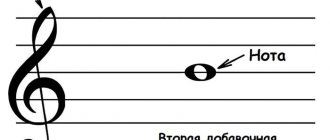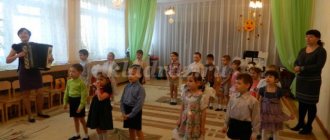Test tasks for diagnosing children's musical abilities
Preparation of test tasks for diagnosing children's musical abilities.
1) Sample tasks for determining modal sense, musical and auditory perceptions, sense of rhythm:
- to establish the level of development of the modal sense:
Exercise 1.
Observing the emotional perception of music. Talk about the content of the music. A conversation about the expressive meaning of dynamics. The nature of melodic intonations, expressive timbres of instruments, conveying the character of the music. You can ask children to depict the character of music in motion.
Task 2.
Composing a melody to a given text. Finish the melody on the tonic. You can use a question and answer form.
Task 3.
Exercises for distinguishing modes.
- to establish the level of development of musical and auditory perceptions
Exercise 1.
Find out the direction of movement of the melody up, down, in place (above or below) Answer on which word the melody changed. (For example, in the songs “Cornflower” or “Cockerel” r. n. melody).
Task 2.
Sing your favorite song, first with accompaniment, then without musical accompaniment. Purely intoning the melody.
Task 3.
Repeat a specially played unfamiliar melody.
- to establish the level of development of the sense of rhythm
Exercise 1.
After listening to a simple melody (8 bars), invite the children to tap its rhythm, and when performing it again, independently reproduce it by clapping or on children’s musical instruments.
Task 2.
After listening to the plays: “Moth”, “Polka”, “March”, S. Maikapara, children must portray a Moth (light, graceful and gentle); cheerful dance; decisive, important confident march.
Emotionally, rhythmically depict musical strokes - legato, staccato, non legato, feel accents, highlight phrases in movements. Give genre characteristics of musical works.
Task 3.
The teacher improvises on the piano. Feel changes in the character and tempo of the music, convey these changes in movements.
2) Test game “Timbre hide and seek”
Target:
identifying the level of timbre hearing by identifying the instrumental or vocal sound of the same melody
- Let's play musical hide and seek with you. Now the same melody will be performed by different voices. Listen and guess whose voice performed it the first, second, third time, etc.
An audio recording of the same melody sounds (for example, V. Vitlin “Little Gray Cat”), performed by the indicated instruments in the sequence: 1) piano, 2) guitar, 3) flute, 4) button accordion, 5) metallophone, 6) duets: guitar + triangle, 7) button accordion + tambourine, 8) xylophone, 9) trio: balalaika + button accordion + drum, 10) piano + button accordion + maracas.
Criteria for evaluation:
- weak level – adequate definition of the timbres of the first three fragments: total = 1 – 3 points;
- average level – adequate definition of the timbre of the first seven fragments performed: total = 4 – 7 points;
- high level – adequate determination of the timbre of a performed musical phrase within 8 – 10 presented fragments: total = 8 – 10 points.
3) Test game “We will go to “Loud and Quiet””
Target:
determination of the ability of an adequate auditory-motor reaction to dynamic changes (strength of expression) of instrumental and vocal-instrumental stimuli.
- Let's play loud and quiet with you. I play the piano and you play the drum. Play like me: I am loud and you are loud, I am quiet and you are quiet (A. Aleksandrov’s piece “Drum” is performed, adequate performance of the contrasting dynamics of which “forte - piano” is assessed at 1 point).
- And now the music will gradually increase or decrease. You will also need to perform it on the drum (E. Parlov’s play “March” is being performed, adequate dynamic performance of the 1st phrase in the dynamics of “crescendo” is estimated at 2 points and the 2nd phrase – “diminuendo” is estimated at 2 points. Total 4 points).
Stimulating material:
drum (or tambourine) and fragments of musical plays - A. Alexandrov “Drum”; E. Parlov “March”.
Criteria for evaluation:
- weak level of dynamic feeling = 1 point;
- average level = 2 – 3 points;
- high level = 4 – 5 points.
4)Test game “Unfinished Melody”
Target:
identify the level of development of the sense of completeness (integrity) of musical thought.
— Now the melodies will be “hidden”: some of them will sound in full, while others will not. Listen and try to determine which melody sounds until the end, and which one is “hidden” ahead of time?
After setting the key, any melody known to the child is performed, for example, “A Christmas tree was born in the forest,” in which the last sound is not played, interrupted by the words “green would...”.
Stimulating material
The diagnostic method can be selected independently by the diagnostician.
The method of using stimulating material is constructed in the following order:
1st melody – the last bar is not played;
2nd melody – played to the end;
3rd – the last phrase of the melody is not played;
4th – interrupted in the middle of the second phrase (out of four);
5th – played to the end.
Criteria for evaluation:
- weak level – 1 – 2 points are correctly identified;
- average level – 3 – 4 points are correctly identified;
- high level – all 5 points are correctly identified.
5)Cat and kitten
Target:
identify the level of formation of the sense of pitch - an adequate sense of the relationships between the pitches of sounds.
— The cat and the kitten were lost in the dark forest. Listen: this is how a cat meows (for example, the sound is played
1), and so – a kitten (a higher sound is performed, for example,
salt
1). Help them find each other. Tell me, when does a cat meow, and when does a kitten meow?
| Code tasks | Presented sounds (first octave, second octave) | Point awarded (for correct answer) | Correct answer |
| 1.1. | mi1 – sol2 | 1 | Cat - kitten |
| 1.2. | sol2 – fa1 | 2 | Kitten - cat |
| 1.3. | fa1 – fa2 | 3 | Cat - kitten |
| 2.1. | fa2 – salt1 | 1 | Kitten - cat |
| 2.2. | mi2 – salt1 | 2 | Kitten - cat |
| 2.3. | la1 – mi2 | 3 | Cat - kitten |
| 3.1. | la1 – re2 | 1 | Cat - kitten |
| 3.2. | re2 – si1 | 2 | Kitten - cat |
| 3.3. | do2 – si1 | 3 | Kitten - cat |
Test presentation algorithm:
First the task is given 1.3.
Next, if the answer is correct –
task 2.3.
, then –
task 3.3.
If the child’s answer turns out to be incorrect, the task is simplified -
1.2.
(where 2 points are awarded for the correct answer), if this task is also performed incorrectly,
task 1.1 is given.
(1 point). And so on for each block.
Criteria for evaluation:
- high level = 7 – 9 points (3+3+3; or 3+3+2; or 3+2+2);
- average level = 4 – 6 points (3+2+1; or 3+1+1; or 2+1+1);
- low level = 1 – 3 points (2+1+0; or 1+1+1; or1+1+0; or 1+0+0).
Diagnostics of musical development of kindergarten students
Diagnostics of musical development
Sample tasks for diagnosing musical abilities
Diagnostics of the metrical sense
“Steps of the Giant, Sasha and the Dwarf”
Target:
identifying the level of development of the sense of meter.
Stimulating material:
an alarm clock (metronome) and marks on the floor indicating the direction of the track. The distance between them corresponds to the child’s free step (15-20cm). There are 16 footprints in total. The path is laid out with turns after every 4th step (for example, along the perimeter of a square). Music in 4/4 time at a moderate tempo.
Musical director:
Let's play fairy steps with you. In the Land of Clocks, all the inhabitants walk like clockwork (the child is given an alarm clock, the sound of which “Tick-tock” is clearly heard, or a metronome is placed nearby) Boy Sasha walks calmly (the teacher demonstrates: step - to the sound of the clock “tick” and an additional step to the sound of the clock “tak”), the steps of his little gnome friend are agile and playful (to the sound of the clock “tick” - a step and an additional step, to the sound of the clock “tak” - the same). The giant walks sedately and importantly (one step per tick-tock clock tick and one additional step at the next tick-tock tick-tock clock tick).
The music is played in 4/4 time at a moderate tempo. The child walks four beats like Sasha, four beats like a gnome, and four beats like a giant.
Criteria for evaluation:
3 points – exact designation of the steps of the “giant, Sasha and the gnome” throughout all 4 “beats” (a beat is equal to four steps, a total of 16 additional steps);
2 points – reproduction of steps with two or three violations of metric coordination. (acceptable limits of violations – from 2 to 8 untimely steps out of 16);
1 point – inconsistent metric execution of steps (from 9 to 12 mismatches).
Diagnosis of the sense of rhythm
Purpose:
identify the level of development of the sense of rhythm.
Musical director: Please clap (or tap) the rhythm of the melodies played on the instrument. (First, a sample of the rhythm is shown to ensure that the child correctly understands the meaning of the task).
Criteria for evaluation:
1 point – weak level of rhythmic regulation. An even row of half durations, an even row of quarter durations.
2 points – average level of rhythmic regulation. Ability to use half, quarter, eighth notes and notes with a dot, i.e. elements of dotted rhythm.
3 points – high level of rhythmic regulation.
Use of dotted, syncopated rhythm and pauses. Diagnostics of pitch hearing
“Cat and kitten”
Target:
identify the level of formation of the pitch sense of pitch relationships.
Musical director:
The cat and the kitten were lost in the dark forest. Listen, this is how a cat meows (performed to the first octave), and a tka is a kitten (performed to the G of the first octave). Help them find each other. Tell me when a cat meows and when a kitten meows.
Sounds are performed sequentially.
| Job No. | Presented sounds | Point awarded | Correct answer |
| 1.1. | Mi1 – salt2 | 1 | Cat - kitten |
| 1.2. | Sol2 – fa1 | 2 | Kitten - cat |
| 1.3. | Fa1 – Fa2 | 3 | Cat - kitten |
| 2.1. | Fa2 – salt1 | 1 | Kitten - cat |
| 2.2. | Mi2 – salt1 | 2 | Kitten - cat |
| 2.3. | A1 – mi2 | 3 | Cat - kitten |
| 3.1. | A1 – re2 | 1 | Cat - kitten |
| 3.2. | Re2 – si1 | 2 | Kitten - cat |
| 3.3. | Do2 – si1 | 3 | Kitten - cat |
Algorithm for presenting the test and assessment criteria: first, task 1.3 is given. Next, if the answer is correct - task 2.3, then task 3.3. If the child’s answer turns out to be incorrect, the task is simplified - 1.2. (where 2 points are awarded for each correct answer), if this task is also performed incorrectly, task 1.1 is given. (1 point) and so on for each block.
Diagnosis of dynamic feeling
The sense of dynamics is determined by the individual’s adequate auditory-motor reaction to the strength of the influencing sound, both in its contrasting presentation and in the gradual strengthening (crescendo) or weakening (diminuendo) of sound dynamics.
Target:
determination of the ability of an adequate auditory-motor reaction to dynamic changes in instrumental and vocal-instrumental stimuli.
Musical director:
Let's play loud and quiet with you. I will play the piano, and you will play the drum. Play like me: I am loud and you are loud, I am quiet and you are quiet (A. Alexandrov’s play “Drum” is performed). Adequate performance of contrasting dynamics “forte - piano” is assessed as 1 point.
And now the music will gradually increase or decrease. You will also need to perform it on the drum. (E. Parlov’s play “March” is performed). Adequate execution of the 1st phrase in the dynamics of “crescendo” is estimated at 2 points and the 2nd phrase – “diminuendo” is estimated at 2 points.
Criteria for evaluation:
1 point scored – a weak level of development of the dynamic sense, is assessed as 1 point.
2 - 3 points scored - the average level of development of the dynamic sense, is assessed as 2 points.
4 - 5 points scored - a high level of development of the dynamic sense, assessed as 3 points.
Diagnostics of the modal-melodic feeling of
the “Chorus Girls”
Target:
identify the level of development of the modal-melodic sense, the reflexive ability to distinguish the modal functions of a melody.
Musical director:
I will play the songs of the cheerful and sad girls, and you listen carefully and tell me which song the cheerful girl sang and which the sad girl.
The songs are composed according to the principle of contrast and comparison of modal functions of the melody. Three singing melodies are presented. For each correct answer, 1 point is awarded.
Criteria for evaluation:
1 point – low level of development of modal and melodic sense. The child identified all the melodies incorrectly or identified only one correctly.
2 points – average level of development of modal and melodic sense. The child gave two correct answers.
3 points – high level of development of modal and melodic sense. The child gave all the correct answers.
Diagnostics of musical activity
It includes diagnostics of skills and abilities in all areas of musical activity:
- Perception of music
- Singing
- Musical and rhythmic movements
- Elementary music playing
- Children's creativity
Sample tasks for diagnosing musical activity
II Junior group
| Indicator under study | Tasks | Grade | Repertoire | |
| Beginning of the year | The end of the year | |||
| 1.Perception | 1.1. Listen to a piece of music (song), respond emotionally to the music | B – listens carefully, expresses his emotions in accordance with the nature of the work S – little expression of emotion, distracted N - indifferent to the sound of music | "Bunny" r.n.m. Arr. Alexandrova | "The cat is sick" "The cat has recovered" Grechaninov |
| 1.2. Recognizing a familiar song | B – by melody C - according to N – didn’t recognize | "Cockerel" r.n.p. arr. M. Kraseva | “Winter has passed” N. Metlova | |
| 2.Singing | 2.1.Singing a familiar song accompanied | B – intones the entire melody C– partially intonates the melody N – does not intonate | “Lullaby of the Bunny” by Karaseva | “Sun” by Gomonova |
| 3. Sense of rhythm | 3.1. Play the simplest rhythmic pattern of a melody by clapping (3-5 sounds) | B – reproduces the rhythm accurately C – reproduces the meter N – random claps | D/i “Repeat after me” | D/i "Three Bears" |
| 3.2. Correspondence of movements to the nature of the music | B- correspond C– partially correspond N – do not correspond | "The Bears" E. Tilicheeva “March” by E. Parlov | “Dance with handkerchiefs” by T. Lomova “Running” by T. Lomova | |
| 3.3. Matching movements to the rhythm of the music | B– corresponds C– partially corresponds N – does not correspond | "Boots" r.n.m. | Rauchwerger's "Stomping Step" | |
Middle group
| Indicator under study | Tasks | Grade | Repertoire | |
| Beginning of the year | The end of the year | |||
| 1. Perception | 1.1. Listen to a piece of music, determine the nature of the music | In balla - feels the character of the music, associations with the image S – feels only the general character, mood N - does not feel the character of the music | P.I. Tchaikovsky “Game of Horses” (“Children’s Album”) | Tchaikovsky "Snowdrop" |
| 1.2. Recognizing a familiar melody from a fragment | B – found out on my own C - with the help N – didn’t recognize | “Sleep, my joy, sleep” W.A. Mozart | “Sun” by E. Gomonova | |
| 1.3. Availability of favorite works | B – have favorite melodies C – one favorite melody I don't have any favorite tunes | |||
| 2. Pitch hearing | 2.1. Sensation of tonic (whether the melody is finished) 5 melodies | B – feels the tonic correctly C – 1.2 errors N – does not feel | "Cornflower" R.n.p. | "Horse" by Tilicheeva |
| 2.2. Register Definition | B – identified correctly (independently) C – identified correctly (with the help) N did not define | D/i “Who sings?” | D/i "Funny beeps" | |
| 2.3. Determining the direction of the melody | B – determined correctly (independently) C – identified correctly (with the help) N did not define | D/i "Lesenka" | D/i "Lesenka" | |
| 3. Singing | 3.1. Singing a familiar song accompanied | B - cleanly intones the entire melody C – purely intonates only segments N – intonates only the general direction of the melody | “Leaves” by Gomonova | “Vesnyanka” by E. Shalamonova (M/n 3/2008) |
| 3.2. Singing a little familiar song with accompaniment | B – cleanly intones the entire melody or segments C– intones only the general direction of the melody N – does not intonate | “Chicken” by Tilicheeva | “Drum” by Tilicheeva | |
| 4. Sense of rhythm | 4.1. Reproduce the rhythmic pattern of the song on percussion instruments | B – reproduces the rhythm accurately C – reproduces the meter N – acts erratically | "Cornflower" R.n.p. | “Trumpet” by Tilicheeva |
| 4.2. Matching movements to the character of the music with contrasting parts | B- correspond C– partially correspond N – do not correspond | “Couples Dance” T. Behrens | “Step with high leg lifts and jumps) Lomovoy | |
| 4.3. Matching movements to the rhythm of the music (using rhythm changes) | B – corresponds C – partially corresponds N – does not correspond | “Let’s Jump” by T. Lomova | “Let’s run, let’s jump” Sosnin | |
| 5. Musical creativity | 5.1. Expressiveness of movements in a familiar dance | B – performs movements expressively, emotionally C – performs movements less expressively and not emotionally N – performs movements without expressiveness or emotion | “Dance with leaves” T. Behrens | "Polka" Stahlbaum |
| 5. 2. Improvisation | B – expressive, original, emotional, independent C - with the help N – failed | P/i "Sparrows and the cat" | P/i "Cat and Mice" | |
Senior group
| Indicator under study | Tasks | Grade | Repertoire | |
| Beginning of the year | The end of the year | |||
| 1. Perception | 1.1. Listen to a piece of music, determine the nature of the music | B – feels the character of the music, associations with the image S – feels only the general character, mood, speaks out with difficulty N - does not feel the character of the music, does not speak out | P.I.Tchaikovsky "Doll Disease" | G. Sviridov "Guy with an Accordion" |
| 1.2. Determine the genre of a piece of music | B – independently C - with the help N – not determined | D/i "Musical traffic light" | D/i "Three Whales" | |
| 1.3. Choose from several illustrations one that suits the work | B – chose correctly on your own C – chose correctly using N – chose wrong | P.I.Tchaikovsky "New Doll" | P.I. Chaikovsky ballet "Swan Lake" "Dance of the Swans" | |
| 2. Pitch hearing | 2.1. Sensation of tonic (whether the melody is finished) 5 melodies | B – feels the tonic correctly C – 1.2 errors N – does not feel | “Circus Dogs” by Tilicheeva | "Woodpecker" N. Levi |
| 2.2. Definition of pure and mixed registers | B – identified correctly (independently) C – identified correctly (with the help) N - not determined | D/i “Who sings?” | D/i "Funny beeps" | |
| 2.3. Determining the number of simultaneously sounding sounds | B – identified correctly (independently) C – identified correctly (with the help) N - not determined | D/i “How many of us?” | D/i “How many of us?” | |
| 3. Singing | 3.1. Singing a familiar song accompanied | B - cleanly intones the entire melody C – purely intonates only segments N – intonates only the general direction of the melody | “Rain” by A. Ponamareva | “Winter is passing” r.n.p. (M/r 1/2008) |
| 3.2. Singing a familiar song without accompaniment (a capella) | B - cleanly intones the entire melody C – intones the direction of the melody N – pronounces words in rhythm | “And the sparrows chirp” by T. Tryapitsyna (M/P No. 4 2008) | “Spring” by I. Menshikh (M/r2/2008) | |
| 3.3. Singing a little familiar song with accompaniment | B – cleanly intones the entire melody or segments C – intonates only the general direction of the melody N – does not intonate | “The Brave Pilot” by Tilicheeva | "Artist" Kabalevsky | |
| 4. Sense of rhythm | 4.1. Reproduce the rhythmic pattern of the melody in claps and percussion instruments | B – reproduces the rhythm accurately C – reproduces meter N – acts erratically | D/i "Cheerful Girlfriends" | D/i “Pass the Rhythm” |
| 4.2. Matching movements to the character of the music with contrasting parts | B - correspond C – partially correspond N – do not correspond | “Step with high leg lifts and jumps” by T. Lomova | "Let's drown and circle" T. Lomovoy | |
| 4.3. Matching movements to the rhythm of the music (using rhythm changes) | B – corresponds C – partially corresponds N – does not correspond | “On a Horse” by V. Vitlin | "Vesnyanka" (u.n.m) | |
| 5. Musical creativity | 5.1. Performing free dance movements | B – performs movements expressively, emotionally C – performs movements less expressively and not emotionally N – performs movements without expressiveness or emotion | “Oh, you canopy” r.n.m. | “Whether in the garden or in the vegetable garden” r.n.p. |
| 5. 2. Improvisation | 3 points – expressive, original, emotional, independent 2 points – with the help 1 point – failed | P/n “Zainka, come out” | P/i "Cat and Mouse" | |
Preparatory group
| Indicator under study | Tasks | Grade | Repertoire | |
| Beginning of the year | The end of the year | |||
| 1. Perception | 1.1. Listen to a piece of music, analyze it (character, genre, rhythm, tempo, dynamics) | B – the child analyzed the music. work on your own C – the child analyzed the music. work with the help of an adult N - the child was unable to characterize the work | P.I. Tchaikovsky “Sleeping Beauty” "Waltz" | P.I. Tchaikovsky "Nutcracker" "Waltz of the Flowers" |
| 1.2. From the two sounded works, choose one that matches the picture. | B – chose correctly and justified his choice C – chose correctly, but did not justify it N – couldn’t choose correctly | D. Kabalevsky “Stubborn Brother”, “Sad Story” (op. 27) | P.I. Tchaikovsky "The Nutcracker" "March", "Dance of the Sugar Plum Fairy" | |
| 1.3. Of several works performed, name those that are close in genre (form, rhythm) | B – named independently C - named with N – didn’t name | D/i "Amazing traffic light" | P/i "Three whales" | |
| 2. Pitch hearing | 2.1. Determine the direction and nature of the movement of the melody (smooth, legato, staccato) | B – feels the tonic correctly C– 1.2 errors N – does not feel | D/i “Tiny House” | D/i "Musical chicks" |
| 2.2. Pick up familiar melodies on a melodic instrument | B – took it myself S – picked up with the help N - didn’t pick it up | “Pea” by Karaseva | P/i "Orchestra" | |
| 2.3. Determining the number of simultaneously sounding sounds | B – identified correctly (independently) C – identified correctly (with the help) N - not determined | D/i “How many of us are singing?” | D/i “How many of us are singing” | |
| 3. Singing | 3.1. Singing a familiar song accompanied | B - cleanly intones the entire melody C – purely intonates only segments N – intonates only the general direction of the melody | “Round dance at Kalinushka” by Yu. Mikhailenko | “About me and the ant” by V. Stepanov |
| 3.2. Singing a familiar song without accompaniment (a capella) | B - cleanly intones the entire melody C – intones the direction of the melody N – pronounces words in rhythm | “Lark” by Eremeeva (M/r No. 5 2006) | “Stubborn ducklings” by E. Krylatov | |
| 3.3. Singing a little familiar song with accompaniment | B – cleanly intones the entire melody or segments C – intonates only the general direction of the melody N – does not intonate | “Like under our gates” r.n.p. | “Blacksmith” by Arseeva | |
| 4. Sense of rhythm | 4.1. Reproduce the rhythmic pattern of the melody in claps and percussion instruments | B – reproduces the rhythm accurately C – reproduces meter N – acts erratically | "To school" music. Tilicheeva | “On a green meadow” r.n.m. |
| 4.2. Matching movements to the character of the music with contrasting parts | B - correspond C – partially correspond N – do not correspond | “Leaps and springy step” by S. Zateplinsky | “Polka” by T. Lomova | |
| 4.3. Matching movements to the rhythm of the music (using rhythm changes) | B – corresponds C – partially corresponds N – does not correspond | “Running and Jumping” by I. Gummel | “Speed up and slow down” by T. Lomova | |
| 5. Musical creativity | 5.1. Performing free dance movements | B – performs movements expressively, emotionally C – performs movements less expressively and not emotionally N – performs movements without expressiveness or emotion | “I’m sitting on a pebble” r.n.p. | “Like thin ice” r.n.p. |
| 5. 2. Improvisation | B – expressive, original, emotional, independent C - with the help N – failed | P/n “Scarecrow” T.Bokach | "Quadrille" (audio), | |





